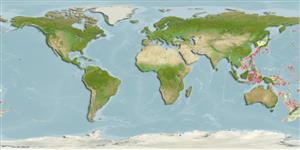Elasmobranquios (tiburones y rayas) (sharks and rays) >
Rajiformes (Skates and rays) >
Anacanthobatidae (Smooth skates)
Etymology:
Environment: milieu / climate zone / depth range / distribution range
Ecología
marino batidemersal; rango de profundidad 800 - 1100 m (Ref. 47737). Deep-water
Western Pacific: South China Sea and Taiwan.
Tamaño / Peso / Age
Maturity: Lm ? range ? - ? cm
Max length : 39.9 cm TL macho / no sexado; (Ref. 47737)
Short description
Morfología | Morfometría
Disc thin. Snout broad and long with rostral filament. Eye small and remote from snout. Pelvic anterior lobe leg-like and completely separate from posterior lobe. Pelvic posterior lobe fused with tail. Tail slender.
Life cycle and mating behavior
Madurez | Reproducción | Puesta | Huevos | Fecundidad | Larva
Distinct pairing with embrace (Ref. 205).
McEachran, J.D. and K.A. Dunn, 1998. Phylogenetic analysis of skates, a morphologically conservative clade of elasmobranchs (Chondrichthyes: Rajidae). Copeia 1998(2):271-290. (Ref. 27314)
IUCN Red List Status (Ref. 130435)
Threat to humans
Harmless
Human uses
Más información
Age/SizeCrecimientoLength-weightLength-lengthLength-frequenciesMorfometríaMorfologíaLarvaDinámica larvariaReclutamientoAbundanciaBRUVS
ReferenciasAcuiculturaPerfil de acuiculturaRazasGenéticaElectrophoresesheritabilidadEnfermedadesProcesamientoNutrientsMass conversion
Herramientas
Special reports
Download XML
Fuentes de Internet
Estimates based on models
Preferred temperature (Ref.
123201): 4.2 - 6.3, mean 5 °C (based on 132 cells).
Phylogenetic diversity index (Ref.
82804): PD
50 = 0.5020 [Uniqueness, from 0.5 = low to 2.0 = high].
Bayesian length-weight: a=0.01000 (0.00244 - 0.04107), b=3.04 (2.81 - 3.27), in cm total length, based on all LWR estimates for this body shape (Ref.
93245).
Nivel trófico (Ref.
69278): 3.7 ±0.6 se; based on size and trophs of closest relatives
Resiliencia (Ref.
120179): Bajo, población duplicada en un tiempo mínimo de 4.5-14 años (Assuming fecundity<100).
Fishing Vulnerability (Ref.
59153): Low to moderate vulnerability (30 of 100).
